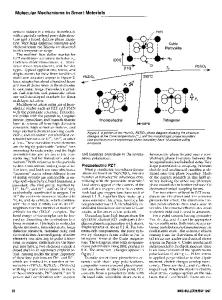Deformation Mechanisms in Nanocrystalline Materials
- PDF / 607,212 Bytes
- 15 Pages / 593.972 x 792 pts Page_size
- 98 Downloads / 417 Views
INTRODUCTION
NANOCRYSTALLINE (nc) materials are characterized by grain sizes £100 nm. Because of the small grains of nc materials, grain boundaries, junction lines, and nodes have significant volume fractions, a characteristic that can influence properties far more strongly than in conventional materials.[1] The nc materials offer interesting possibilities related to many structural applications. In order to explore some of these possibilities, an understanding of the origin and nature of deformation processes in nc materials is essential. Such understanding is important in two ways. First, when the origin of the deformation process is uncovered in sufficient detail, it should be possible to predict the mechanical behavior under a variety of conditions (stress, temperature, and grain size). Second, when the basic deformation process is known (successfully identified or developed), it is possible to introduce microstructural features that can improve the mechanical behavior of the materials in terms of ductility, toughness, etc. As a result of recent investigations of nc materials, several deformation mechanisms have been proposed. These mechanisms are different in terms of concept and details. In addition, extensive experimental data on the mechanical behavior of nc materials such as nc Ni and FARGHALLI A. MOHAMED, Professor, and HEATHER YANG, Graduate Research Assistant, are with the Department of Chemical Engineering and Materials Science, University of California, Irvine, CA 92697-2575. Contact e-mail: [email protected] This article is based on a presentation given in the symposium entitled ‘‘Mechanical Behavior of Nanostructured Materials,’’ which occurred during the TMS Spring Meeting in San Francisco, CA, February 15–19, 2009, under the auspices of TMS, the TMS Electronic, Magnetic, and Photonic Materials Division, the TMS Materials Processing and Manufacturing Division, the TMS Structural Materials Division, the TMS Nanomechanical Materials Behavior Committee, the TMS Chemistry and Physics of Materials Committee, and the TMS/ASM Mechanical Behavior of Materials Committee. Article published online November 24, 2009 METALLURGICAL AND MATERIALS TRANSACTIONS A
nc Cu have become available. The availability of the experimental data on these two metals provides an opportunity to closely examine the validity of deformation mechanisms that were proposed to account for the characteristics of deformation in nc materials. Accordingly, the objective of this article is twofold, as follows: (1) to identify the requirements that a deformation mechanism should meet in terms of accounting for the mechanical characteristics and trends that are revealed by the experimental data and (2) to assess available deformation mechanisms in the light of these requirements.
II.
ANALYSIS
A. Requirements for a Successful Deformation Mechanism In order to identify or develop deformation processes, guiding information is needed. This guiding information can be obtained in part from experimental measurements. During the period 1990 to 2008, exper
Data Loading...











